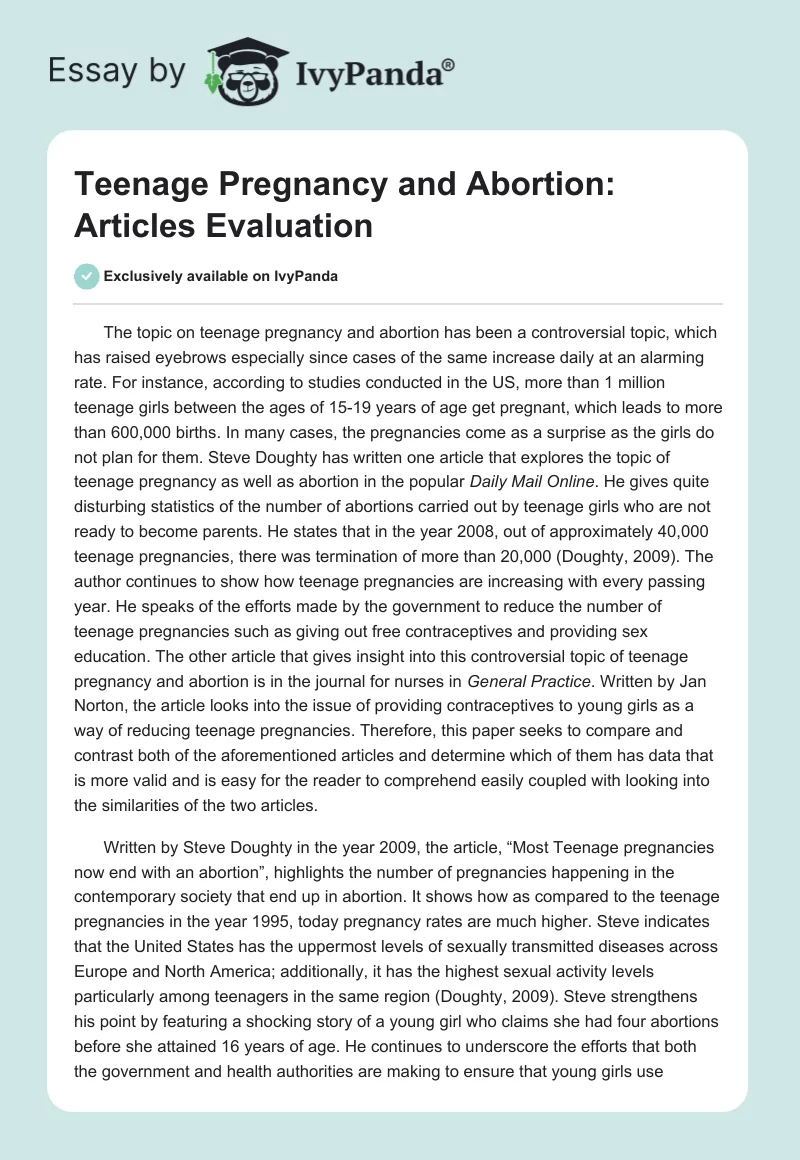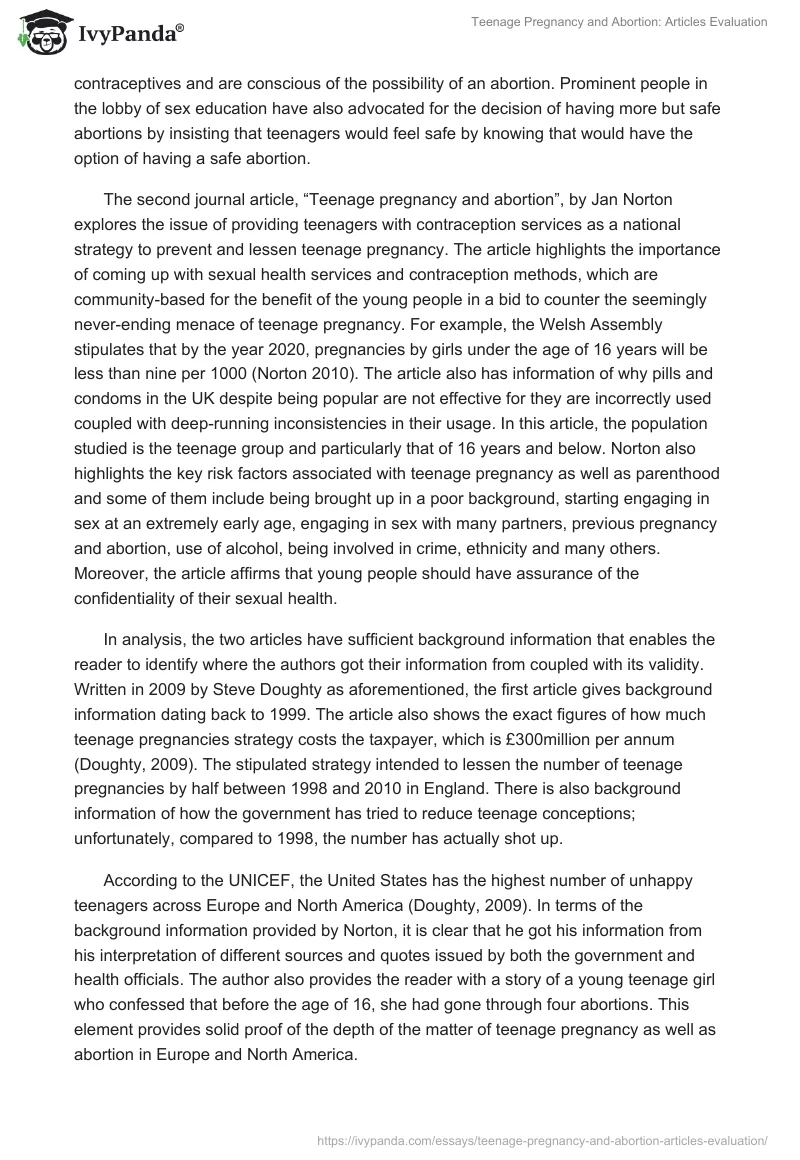The topic on teenage pregnancy and abortion has been a controversial topic, which has raised eyebrows especially since cases of the same increase daily at an alarming rate. For instance, according to studies conducted in the US, more than 1 million teenage girls between the ages of 15-19 years of age get pregnant, which leads to more than 600,000 births. In many cases, the pregnancies come as a surprise as the girls do not plan for them. Steve Doughty has written one article that explores the topic of teenage pregnancy as well as abortion in the popular Daily Mail Online. He gives quite disturbing statistics of the number of abortions carried out by teenage girls who are not ready to become parents. He states that in the year 2008, out of approximately 40,000 teenage pregnancies, there was termination of more than 20,000 (Doughty, 2009).
The author continues to show how teenage pregnancies are increasing with every passing year. He speaks of the efforts made by the government to reduce the number of teenage pregnancies such as giving out free contraceptives and providing sex education. The other article that gives insight into this controversial topic of teenage pregnancy and abortion is in the journal for nurses in General Practice. Written by Jan Norton, the article looks into the issue of providing contraceptives to young girls as a way of reducing teenage pregnancies. Therefore, this paper seeks to compare and contrast both of the aforementioned articles and determine which of them has data that is more valid and is easy for the reader to comprehend easily coupled with looking into the similarities of the two articles.
Written by Steve Doughty in the year 2009, the article, “Most Teenage pregnancies now end with an abortion”, highlights the number of pregnancies happening in the contemporary society that end up in abortion. It shows how as compared to the teenage pregnancies in the year 1995, today pregnancy rates are much higher. Steve indicates that the United States has the uppermost levels of sexually transmitted diseases across Europe and North America; additionally, it has the highest sexual activity levels particularly among teenagers in the same region (Doughty, 2009). Steve strengthens his point by featuring a shocking story of a young girl who claims she had four abortions before she attained 16 years of age. He continues to underscore the efforts that both the government and health authorities are making to ensure that young girls use contraceptives and are conscious of the possibility of an abortion. Prominent people in the lobby of sex education have also advocated for the decision of having more but safe abortions by insisting that teenagers would feel safe by knowing that would have the option of having a safe abortion.
The second journal article, “Teenage pregnancy and abortion”, by Jan Norton explores the issue of providing teenagers with contraception services as a national strategy to prevent and lessen teenage pregnancy. The article highlights the importance of coming up with sexual health services and contraception methods, which are community-based for the benefit of the young people in a bid to counter the seemingly never-ending menace of teenage pregnancy. For example, the Welsh Assembly stipulates that by the year 2020, pregnancies by girls under the age of 16 years will be less than nine per 1000 (Norton 2010). The article also has information of why pills and condoms in the UK despite being popular are not effective for they are incorrectly used coupled with deep-running inconsistencies in their usage. In this article, the population studied is the teenage group and particularly that of 16 years and below. Norton also highlights the key risk factors associated with teenage pregnancy as well as parenthood and some of them include being brought up in a poor background, starting engaging in sex at an extremely early age, engaging in sex with many partners, previous pregnancy and abortion, use of alcohol, being involved in crime, ethnicity and many others. Moreover, the article affirms that young people should have assurance of the confidentiality of their sexual health.
In analysis, the two articles have sufficient background information that enables the reader to identify where the authors got their information from coupled with its validity. Written in 2009 by Steve Doughty as aforementioned, the first article gives background information dating back to 1999. The article also shows the exact figures of how much teenage pregnancies strategy costs the taxpayer, which is £300million per annum (Doughty, 2009). The stipulated strategy intended to lessen the number of teenage pregnancies by half between 1998 and 2010 in England. There is also background information of how the government has tried to reduce teenage conceptions; unfortunately, compared to 1998, the number has actually shot up.
According to the UNICEF, the United States has the highest number of unhappy teenagers across Europe and North America (Doughty, 2009). In terms of the background information provided by Norton, it is clear that he got his information from his interpretation of different sources and quotes issued by both the government and health officials. The author also provides the reader with a story of a young teenage girl who confessed that before the age of 16, she had gone through four abortions. This element provides solid proof of the depth of the matter of teenage pregnancy as well as abortion in Europe and North America.
Steve’s information background provides a valid and factual paper such that one can appreciate the importance of this topic. However, the fact that he did not do the research himself and only wrote what he got from other sources makes it a bit plain as opposed to conducting primary research with a hypothesis, methodology, and all other elements of a research paper.
The other article written by Jay Norton has a lot of background information compared to the first article. For example, it has quite a number of different statistics given by the Teenage Pregnancy Unit. The majority of information relates to the UK whereby there have been strategies put in place to reduce teenage pregnancy. The fact that the article appears in a journal makes it authentic and valid. The hypothesis of this article is that teenage pregnancy, particularly between black Caribbean youths and mixed whites showed considerably higher rates (Norton 2010).
Part of the methodology used is having a variety of approaches conducted in Wales, England, Northern Ireland, and Scotland. Most of these strategies set a target of what they wanted to achieve and by what specific time. For example, the Strategy and Action Plan meant to make sexual health better targeted to reduce teenage pregnancy rate by 50 per cent by the year 2010 all the way from 8.5 percent in 1995 (Norton, 2010). The article focuses on various sub-topics in relation to the key topic of abortion and teenage pregnancy. For instance, it looks into identifying the characteristics of the young people who are more prone to getting early pregnancy coupled with many other aspects. Census data obtained in the year 2001 is mentioned in the article where there is a comparison of rate teenage pregnancy between Black Caribbeans and mixed White. The fact that the information is very recent makes the article even more valid as it shows what is currently happening amongst teenagers in terms of their sexual health.
From the articles, I have learnt invaluable novel ideas and perspectives. The main thing that I learned is that some people advocate for abortion as a strategy of reducing unwanted pregnancies in teenage girls. According to Doughty (2009), abortion proponents are currently pushing for propositions of placing abortion adverts in television commercials as a way of sensitizing young people that they have an option to abort. This realization caught my attention for in most cases; abortion is an abominable practice perhaps due to religious, ethical, or safety reasons. I have learnt that sociology deals with different aspects of human life and pregnancy and abortion of teenagers is one of them. The increasing teenage pregnancy is a worrying trend. Besides pregnancy, the issue of teenagers engaging in sex comes with a number of other grave consequences like getting sexually transmitted diseases with in the inclusion of HIV, which up to now has no cure. This realization underscores why the efforts to educate young people on the dangers of early sex should be the first priority.
References
Doughty, S. (2009). Most teenage pregnancies now end with an abortion. Web.
Norton, J. (2010).Teenage pregnancy and abortion. Practice Nurse, 39(5), 43-49.


